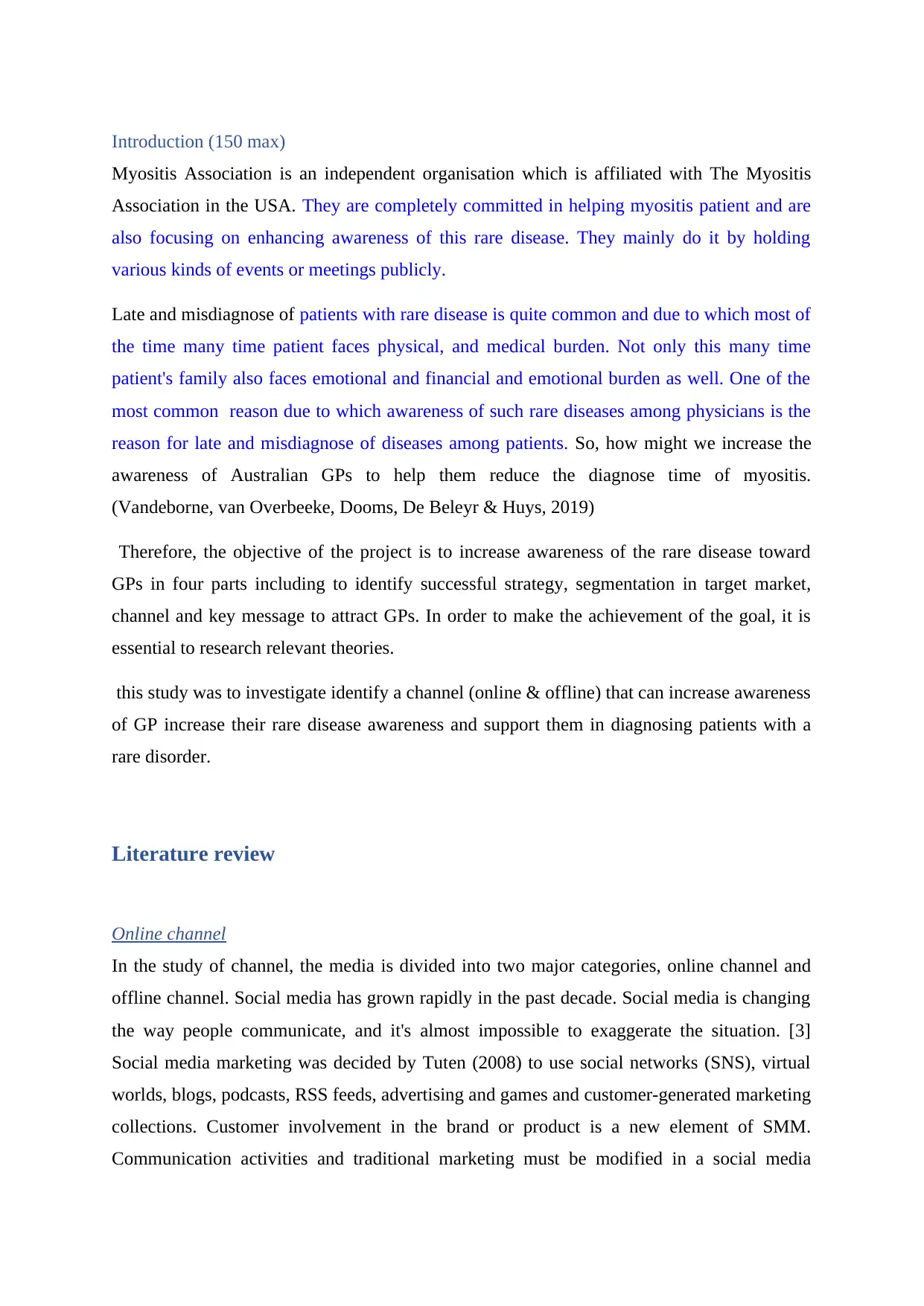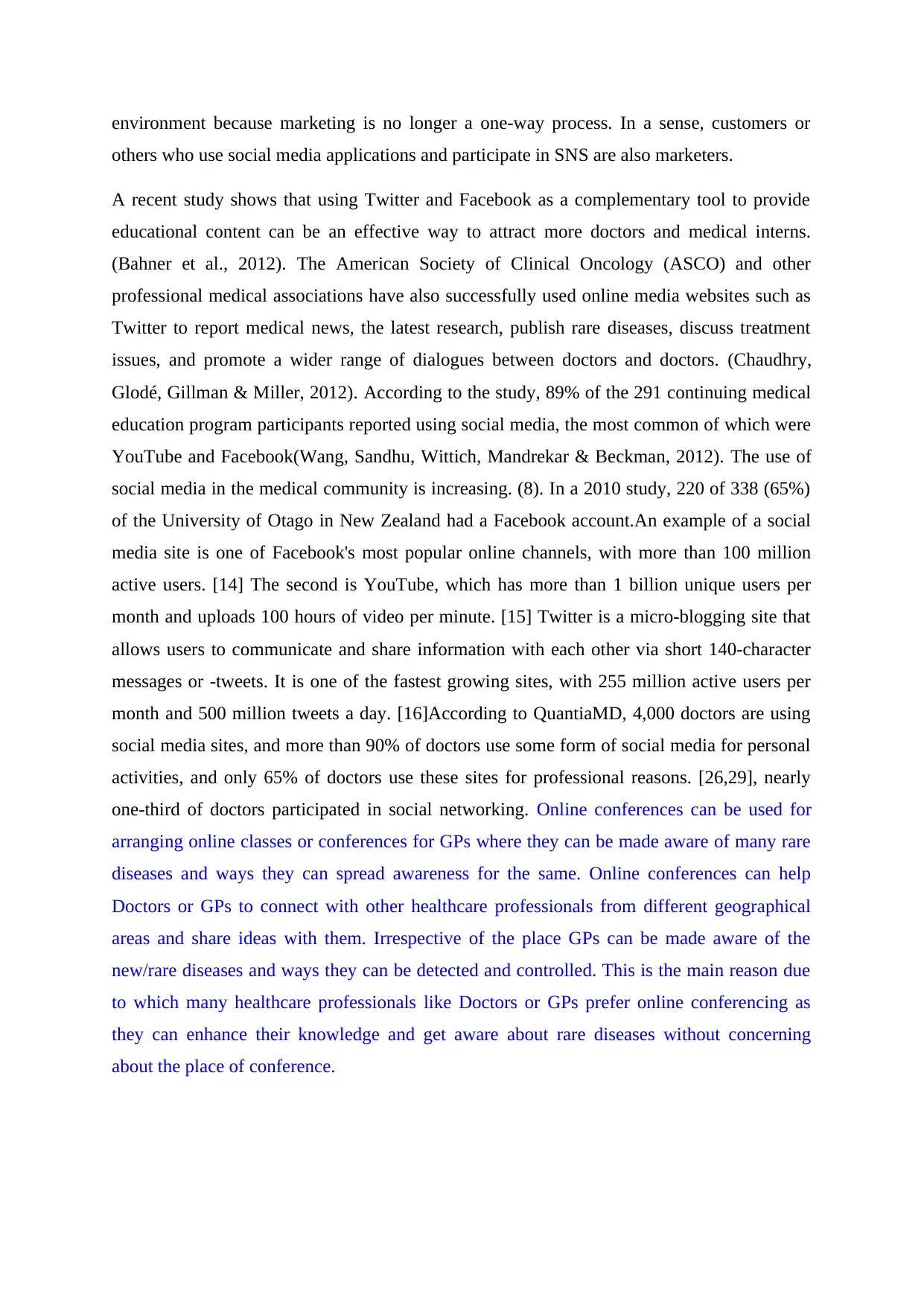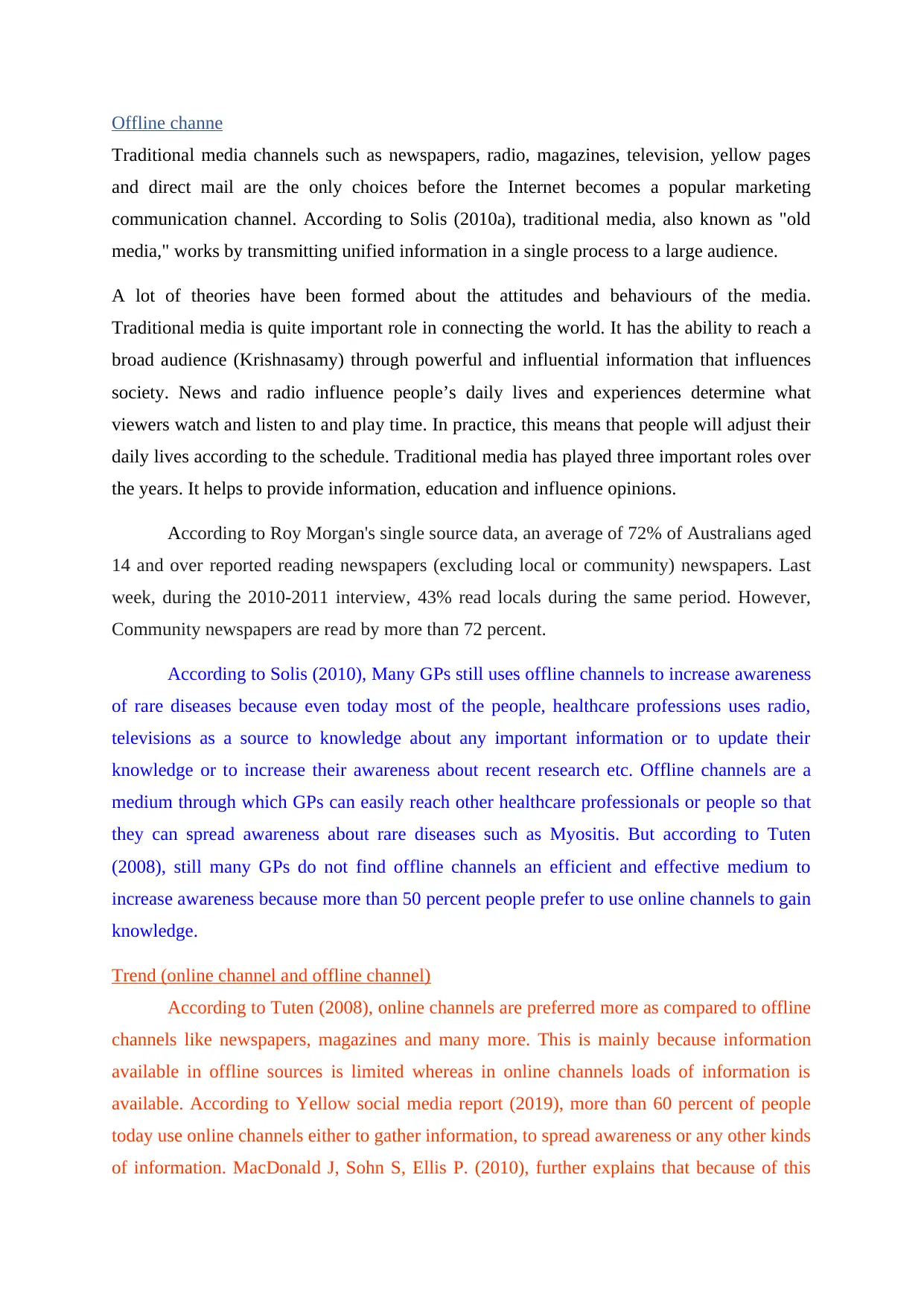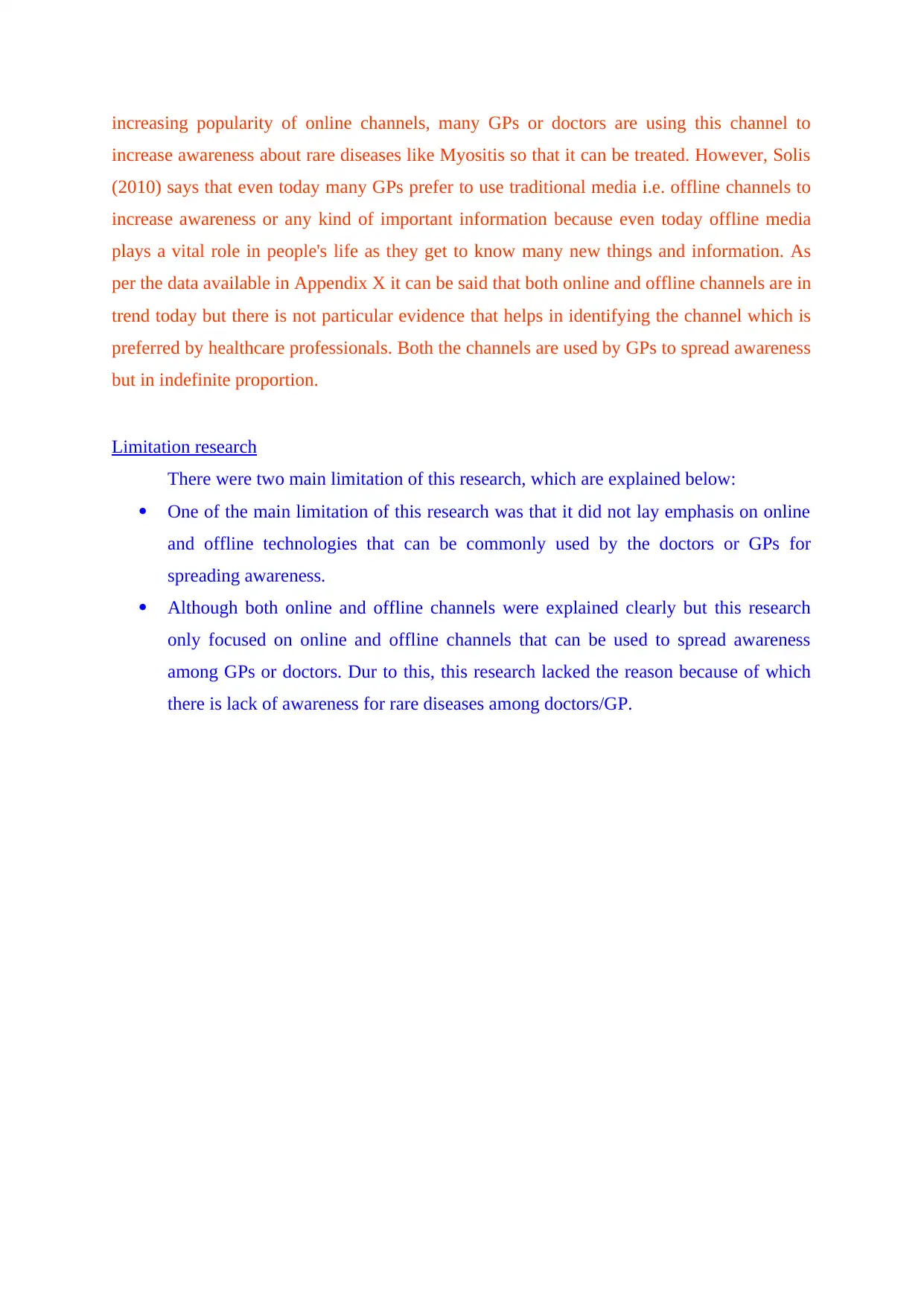Analysis of Channels to Increase Myositis Awareness for Australian GPs
VerifiedAdded on 2021/02/19
|4
|1581
|33
Report
AI Summary
This report investigates strategies to increase awareness of myositis, a rare disease, among Australian GPs to reduce diagnosis time. The research explores both online and offline channels, examining their effectiveness in reaching and educating GPs. The literature review highlights the growing importance of online channels, particularly social media, for medical professionals, including platforms like Twitter and Facebook. It also acknowledges the continued relevance of offline channels, such as newspapers and magazines, though their influence is perceived to be declining. The report analyzes trends in channel preference, acknowledging the limitations of the research, and identifies potential strategies for improving awareness. The report also emphasizes the importance of considering the role of both online and offline channels in increasing awareness and knowledge about rare diseases like Myositis.

Introduction (150 max)
Myositis Association is an independent organisation which is affiliated with The Myositis
Association in the USA. They are completely committed in helping myositis patient and are
also focusing on enhancing awareness of this rare disease. They mainly do it by holding
various kinds of events or meetings publicly.
Late and misdiagnose of patients with rare disease is quite common and due to which most of
the time many time patient faces physical, and medical burden. Not only this many time
patient's family also faces emotional and financial and emotional burden as well. One of the
most common reason due to which awareness of such rare diseases among physicians is the
reason for late and misdiagnose of diseases among patients. So, how might we increase the
awareness of Australian GPs to help them reduce the diagnose time of myositis.
(Vandeborne, van Overbeeke, Dooms, De Beleyr & Huys, 2019)
Therefore, the objective of the project is to increase awareness of the rare disease toward
GPs in four parts including to identify successful strategy, segmentation in target market,
channel and key message to attract GPs. In order to make the achievement of the goal, it is
essential to research relevant theories.
this study was to investigate identify a channel (online & offline) that can increase awareness
of GP increase their rare disease awareness and support them in diagnosing patients with a
rare disorder.
Literature review
Online channel
In the study of channel, the media is divided into two major categories, online channel and
offline channel. Social media has grown rapidly in the past decade. Social media is changing
the way people communicate, and it's almost impossible to exaggerate the situation. [3]
Social media marketing was decided by Tuten (2008) to use social networks (SNS), virtual
worlds, blogs, podcasts, RSS feeds, advertising and games and customer-generated marketing
collections. Customer involvement in the brand or product is a new element of SMM.
Communication activities and traditional marketing must be modified in a social media
Myositis Association is an independent organisation which is affiliated with The Myositis
Association in the USA. They are completely committed in helping myositis patient and are
also focusing on enhancing awareness of this rare disease. They mainly do it by holding
various kinds of events or meetings publicly.
Late and misdiagnose of patients with rare disease is quite common and due to which most of
the time many time patient faces physical, and medical burden. Not only this many time
patient's family also faces emotional and financial and emotional burden as well. One of the
most common reason due to which awareness of such rare diseases among physicians is the
reason for late and misdiagnose of diseases among patients. So, how might we increase the
awareness of Australian GPs to help them reduce the diagnose time of myositis.
(Vandeborne, van Overbeeke, Dooms, De Beleyr & Huys, 2019)
Therefore, the objective of the project is to increase awareness of the rare disease toward
GPs in four parts including to identify successful strategy, segmentation in target market,
channel and key message to attract GPs. In order to make the achievement of the goal, it is
essential to research relevant theories.
this study was to investigate identify a channel (online & offline) that can increase awareness
of GP increase their rare disease awareness and support them in diagnosing patients with a
rare disorder.
Literature review
Online channel
In the study of channel, the media is divided into two major categories, online channel and
offline channel. Social media has grown rapidly in the past decade. Social media is changing
the way people communicate, and it's almost impossible to exaggerate the situation. [3]
Social media marketing was decided by Tuten (2008) to use social networks (SNS), virtual
worlds, blogs, podcasts, RSS feeds, advertising and games and customer-generated marketing
collections. Customer involvement in the brand or product is a new element of SMM.
Communication activities and traditional marketing must be modified in a social media
Paraphrase This Document
Need a fresh take? Get an instant paraphrase of this document with our AI Paraphraser

environment because marketing is no longer a one-way process. In a sense, customers or
others who use social media applications and participate in SNS are also marketers.
A recent study shows that using Twitter and Facebook as a complementary tool to provide
educational content can be an effective way to attract more doctors and medical interns.
(Bahner et al., 2012). The American Society of Clinical Oncology (ASCO) and other
professional medical associations have also successfully used online media websites such as
Twitter to report medical news, the latest research, publish rare diseases, discuss treatment
issues, and promote a wider range of dialogues between doctors and doctors. (Chaudhry,
Glodé, Gillman & Miller, 2012). According to the study, 89% of the 291 continuing medical
education program participants reported using social media, the most common of which were
YouTube and Facebook(Wang, Sandhu, Wittich, Mandrekar & Beckman, 2012). The use of
social media in the medical community is increasing. (8). In a 2010 study, 220 of 338 (65%)
of the University of Otago in New Zealand had a Facebook account.An example of a social
media site is one of Facebook's most popular online channels, with more than 100 million
active users. [14] The second is YouTube, which has more than 1 billion unique users per
month and uploads 100 hours of video per minute. [15] Twitter is a micro-blogging site that
allows users to communicate and share information with each other via short 140-character
messages or -tweets. It is one of the fastest growing sites, with 255 million active users per
month and 500 million tweets a day. [16]According to QuantiaMD, 4,000 doctors are using
social media sites, and more than 90% of doctors use some form of social media for personal
activities, and only 65% of doctors use these sites for professional reasons. [26,29], nearly
one-third of doctors participated in social networking. Online conferences can be used for
arranging online classes or conferences for GPs where they can be made aware of many rare
diseases and ways they can spread awareness for the same. Online conferences can help
Doctors or GPs to connect with other healthcare professionals from different geographical
areas and share ideas with them. Irrespective of the place GPs can be made aware of the
new/rare diseases and ways they can be detected and controlled. This is the main reason due
to which many healthcare professionals like Doctors or GPs prefer online conferencing as
they can enhance their knowledge and get aware about rare diseases without concerning
about the place of conference.
others who use social media applications and participate in SNS are also marketers.
A recent study shows that using Twitter and Facebook as a complementary tool to provide
educational content can be an effective way to attract more doctors and medical interns.
(Bahner et al., 2012). The American Society of Clinical Oncology (ASCO) and other
professional medical associations have also successfully used online media websites such as
Twitter to report medical news, the latest research, publish rare diseases, discuss treatment
issues, and promote a wider range of dialogues between doctors and doctors. (Chaudhry,
Glodé, Gillman & Miller, 2012). According to the study, 89% of the 291 continuing medical
education program participants reported using social media, the most common of which were
YouTube and Facebook(Wang, Sandhu, Wittich, Mandrekar & Beckman, 2012). The use of
social media in the medical community is increasing. (8). In a 2010 study, 220 of 338 (65%)
of the University of Otago in New Zealand had a Facebook account.An example of a social
media site is one of Facebook's most popular online channels, with more than 100 million
active users. [14] The second is YouTube, which has more than 1 billion unique users per
month and uploads 100 hours of video per minute. [15] Twitter is a micro-blogging site that
allows users to communicate and share information with each other via short 140-character
messages or -tweets. It is one of the fastest growing sites, with 255 million active users per
month and 500 million tweets a day. [16]According to QuantiaMD, 4,000 doctors are using
social media sites, and more than 90% of doctors use some form of social media for personal
activities, and only 65% of doctors use these sites for professional reasons. [26,29], nearly
one-third of doctors participated in social networking. Online conferences can be used for
arranging online classes or conferences for GPs where they can be made aware of many rare
diseases and ways they can spread awareness for the same. Online conferences can help
Doctors or GPs to connect with other healthcare professionals from different geographical
areas and share ideas with them. Irrespective of the place GPs can be made aware of the
new/rare diseases and ways they can be detected and controlled. This is the main reason due
to which many healthcare professionals like Doctors or GPs prefer online conferencing as
they can enhance their knowledge and get aware about rare diseases without concerning
about the place of conference.

Offline channe
Traditional media channels such as newspapers, radio, magazines, television, yellow pages
and direct mail are the only choices before the Internet becomes a popular marketing
communication channel. According to Solis (2010a), traditional media, also known as "old
media," works by transmitting unified information in a single process to a large audience.
A lot of theories have been formed about the attitudes and behaviours of the media.
Traditional media is quite important role in connecting the world. It has the ability to reach a
broad audience (Krishnasamy) through powerful and influential information that influences
society. News and radio influence people’s daily lives and experiences determine what
viewers watch and listen to and play time. In practice, this means that people will adjust their
daily lives according to the schedule. Traditional media has played three important roles over
the years. It helps to provide information, education and influence opinions.
According to Roy Morgan's single source data, an average of 72% of Australians aged
14 and over reported reading newspapers (excluding local or community) newspapers. Last
week, during the 2010-2011 interview, 43% read locals during the same period. However,
Community newspapers are read by more than 72 percent.
According to Solis (2010), Many GPs still uses offline channels to increase awareness
of rare diseases because even today most of the people, healthcare professions uses radio,
televisions as a source to knowledge about any important information or to update their
knowledge or to increase their awareness about recent research etc. Offline channels are a
medium through which GPs can easily reach other healthcare professionals or people so that
they can spread awareness about rare diseases such as Myositis. But according to Tuten
(2008), still many GPs do not find offline channels an efficient and effective medium to
increase awareness because more than 50 percent people prefer to use online channels to gain
knowledge.
Trend (online channel and offline channel)
According to Tuten (2008), online channels are preferred more as compared to offline
channels like newspapers, magazines and many more. This is mainly because information
available in offline sources is limited whereas in online channels loads of information is
available. According to Yellow social media report (2019), more than 60 percent of people
today use online channels either to gather information, to spread awareness or any other kinds
of information. MacDonald J, Sohn S, Ellis P. (2010), further explains that because of this
Traditional media channels such as newspapers, radio, magazines, television, yellow pages
and direct mail are the only choices before the Internet becomes a popular marketing
communication channel. According to Solis (2010a), traditional media, also known as "old
media," works by transmitting unified information in a single process to a large audience.
A lot of theories have been formed about the attitudes and behaviours of the media.
Traditional media is quite important role in connecting the world. It has the ability to reach a
broad audience (Krishnasamy) through powerful and influential information that influences
society. News and radio influence people’s daily lives and experiences determine what
viewers watch and listen to and play time. In practice, this means that people will adjust their
daily lives according to the schedule. Traditional media has played three important roles over
the years. It helps to provide information, education and influence opinions.
According to Roy Morgan's single source data, an average of 72% of Australians aged
14 and over reported reading newspapers (excluding local or community) newspapers. Last
week, during the 2010-2011 interview, 43% read locals during the same period. However,
Community newspapers are read by more than 72 percent.
According to Solis (2010), Many GPs still uses offline channels to increase awareness
of rare diseases because even today most of the people, healthcare professions uses radio,
televisions as a source to knowledge about any important information or to update their
knowledge or to increase their awareness about recent research etc. Offline channels are a
medium through which GPs can easily reach other healthcare professionals or people so that
they can spread awareness about rare diseases such as Myositis. But according to Tuten
(2008), still many GPs do not find offline channels an efficient and effective medium to
increase awareness because more than 50 percent people prefer to use online channels to gain
knowledge.
Trend (online channel and offline channel)
According to Tuten (2008), online channels are preferred more as compared to offline
channels like newspapers, magazines and many more. This is mainly because information
available in offline sources is limited whereas in online channels loads of information is
available. According to Yellow social media report (2019), more than 60 percent of people
today use online channels either to gather information, to spread awareness or any other kinds
of information. MacDonald J, Sohn S, Ellis P. (2010), further explains that because of this
⊘ This is a preview!⊘
Do you want full access?
Subscribe today to unlock all pages.

Trusted by 1+ million students worldwide

increasing popularity of online channels, many GPs or doctors are using this channel to
increase awareness about rare diseases like Myositis so that it can be treated. However, Solis
(2010) says that even today many GPs prefer to use traditional media i.e. offline channels to
increase awareness or any kind of important information because even today offline media
plays a vital role in people's life as they get to know many new things and information. As
per the data available in Appendix X it can be said that both online and offline channels are in
trend today but there is not particular evidence that helps in identifying the channel which is
preferred by healthcare professionals. Both the channels are used by GPs to spread awareness
but in indefinite proportion.
Limitation research
There were two main limitation of this research, which are explained below:
One of the main limitation of this research was that it did not lay emphasis on online
and offline technologies that can be commonly used by the doctors or GPs for
spreading awareness.
Although both online and offline channels were explained clearly but this research
only focused on online and offline channels that can be used to spread awareness
among GPs or doctors. Dur to this, this research lacked the reason because of which
there is lack of awareness for rare diseases among doctors/GP.
increase awareness about rare diseases like Myositis so that it can be treated. However, Solis
(2010) says that even today many GPs prefer to use traditional media i.e. offline channels to
increase awareness or any kind of important information because even today offline media
plays a vital role in people's life as they get to know many new things and information. As
per the data available in Appendix X it can be said that both online and offline channels are in
trend today but there is not particular evidence that helps in identifying the channel which is
preferred by healthcare professionals. Both the channels are used by GPs to spread awareness
but in indefinite proportion.
Limitation research
There were two main limitation of this research, which are explained below:
One of the main limitation of this research was that it did not lay emphasis on online
and offline technologies that can be commonly used by the doctors or GPs for
spreading awareness.
Although both online and offline channels were explained clearly but this research
only focused on online and offline channels that can be used to spread awareness
among GPs or doctors. Dur to this, this research lacked the reason because of which
there is lack of awareness for rare diseases among doctors/GP.
1 out of 4
Related Documents
Your All-in-One AI-Powered Toolkit for Academic Success.
+13062052269
info@desklib.com
Available 24*7 on WhatsApp / Email
![[object Object]](/_next/static/media/star-bottom.7253800d.svg)
Unlock your academic potential
Copyright © 2020–2025 A2Z Services. All Rights Reserved. Developed and managed by ZUCOL.





